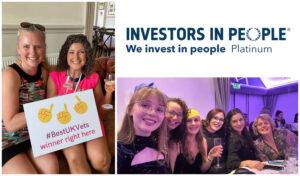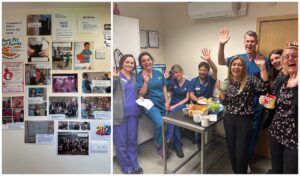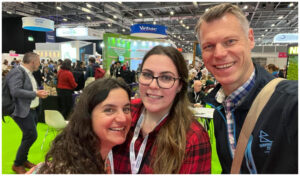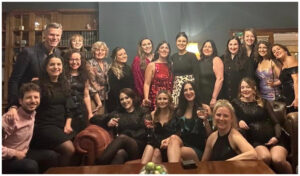by Santino Elkington
Meraki HQ, Totnes, UK
Created 737 days ago
Leadership Spotlight: 387 Veterinary Centre
387 Veterinary Centre joined Meraki earlier this year. Wanting to gain a deeper insight into their efforts to create a great place to work, we sat down with Rachel Duncan to chat about all things team and culture. We covered the origins of the business, building the team, employee wellbeing, personal development, EMS, performance management and more!
“We’re very big on inclusivity, empowerment and progression”
Hi Rachel, thank you for joining me. Can you tell me a little bit about yourself, 387 Vets and what has brought you to where you are today?
I am Non-Clinical Director and Practice Manager at 387 Veterinary Centre in the West Midlands. My entrance into the veterinary world was a little bit unorthodox.
I started out as a secondary school teacher in English literature and English language. I then went into educational publishing. But it wasn’t until my husband Hamish, the Clinical Director, decided that he’d like to set up his own practice that I really got involved in the industry.
We started from scratch in 2007 in a detached house. We converted the garage, replaced a beautiful kitchen with dog kennels and the business has evolved from there. Having started as a one vet, one nurse and a part-time receptionist practice with two consult rooms, we are now 25 strong and actively recruiting further team members.
Since 2007 we have undergone two large development projects to extend the practice and create more consulting space to offer a more niche service. Next year will see our third development project to create more operating space and further improve team facilities.
Figure 1: Rachel (left) and Cody lead veterinary nurse (right) attending the Vet Help Direct Awards in London and the 387 Veterinary Centre team enjoying their 2023 Christmas party

Tell me a little about how you built up the business to make it what it is today, specifically focusing on how you built up the team.
At the beginning, we didn’t know whether anybody was going to come through the door. Our focus was very much on generating a client base and getting pets to come in. The first four years of the business we were very much like this, looking outwards rather than inwards.
We started to appoint more team members and then in about 2011, decided that it was really time to focus on our team. After a couple of blips with team members we sought external support to basically improve our leadership and management skills.
To help the business move forwards and improve the wellbeing of our team we joined the ‘Investors in People’ scheme in 2012 (Figure 1). This provides a framework to build people skills within organisations with a focus on leading, supporting and increasing the capability of your team.
That has been very much the basis for everything we’ve done with regard to team wellbeing and bonding within the practice. We’re very big on inclusivity, empowerment and progression, these are three of our key themes that have really come from our Investors in People journey.
Can you share an insight into what inclusivity as a workplace theme looks like for you?
We are super keen on facilitating individual team member contribution so that everyone has a voice. If team members are not comfortable speaking in our bigger practice and clinical meetings, they can propose ideas in our regular sub-team meetings. We have these for receptionists, nurses, vets, management and are about to introduce them for our student vet nurse team led by our lead nurse. Agendas are open for team contribution so that meetings are not simply management-led.
We also introduced Continuous Improvement System meetings this summer, led by a dedicated CIS champion who chairs fortnightly get togethers. Everyone in the practice is rostered off PMS to attend, except for management! The process results in cross-team collaboration and people working with others in different job roles to share knowledge and design better systems.
People submit action cards prior to the meeting with ideas for improving workflows. Action cards can be anything work-related, for example wellbeing, performance, customer service and dealing with niggles. An action point for implementing change is agreed at the CIS meeting and written on the card. Progress is reviewed at the next meeting and additional action points added as necessary to embed the new strategy as part of continuous but manageable team-led change.
“…it’s about getting the feedback from the assessor to implement positive change, to help people realise their ambitions”
That sounds great! What impact has Investors in People had on the business and team dynamics?
It has been very incremental. Team wellbeing and change is not something that happens quickly. Hamish and I had no leadership or management training when we started the business and we’ve been doing the Investors in People project for nearly 12 years now.
Our Investors in People journey has given us frameworks to benchmark and examine our processes, our policies and how we could include the team more in decision making. We also looked at people being accountable for their learning and contributions and how we could show that everybody was as important as one another. We wanted to ensure everyone felt valued and were able to see their impact on driving the business forward.
In 2013 we were accredited at Core Level, but our past two accreditations have been Platinum, the highest award level. To achieve platinum is lovely, but really it’s about getting the feedback from the assessor to implement positive change, to help people realise their ambitions, unite the team and to create a nice place to be during work-hours.
Off the back of this we have nurtured a very settled, collaborative and supportive team. Everybody looks out for everybody else, and we all share similar values and ethos that we came together to agree as part of this ongoing project.
Can you share an example of how a specific team member has been supported?
We’re very big on wellbeing, and that’s not just workplace wellbeing if people are struggling with things outside work. Myself as a member of the management team have a mental health first aid certificate along with one of our clinical team. She is very compassionate, bubbly and friendly. Everybody loves her.
When people come to work with us, we invite them to complete a wellbeing action plan. This is a document that gets people to identify things that might cause them stress at work.
We also completed a 20-week wellbeing project with an external company to identify stress within the workplace. Out of this we created a wellbeing ‘fix it’ list, reviewed on a two-monthly basis to identify sticking points at work and what we could do to make things better for everyone. As practice, team and systems have changed, wellbeing ‘fix its’ have now become part of our CIS meetings.
To minimise stress in the workplace we use practice mentors to help co-workers understand and do their job to the best of their ability. In certain situations we have looked at reducing people’s time at work if people have been struggling, even directing people towards counselling. We also provide enhanced sick and compassionate leave pay so that if people feel they need to take time off work, it’s not at the detriment of their pay packet.
Figure 2: 387 Veterinary Centre wall ‘Snapshot of 2023’ and the team enjoying a coffee break

What signs of stress have you become sensitive to look out for in the team?
It will vary between individuals. For some people it will be struggling to communicate, becoming introverted, going into their shell and not being their usual selves. For others it might be the complete opposite where people will start to speak very quickly because they feel under pressure and panic. Others might cry.
We encourage everybody at work to reach out to team members if you notice something different about their behaviour. Our wellbeing training helped us create an accountability toolkit, so that if you notice somebody is a bit off or perhaps a little bit short, then it’s up to the individual that’s noticed to enquire in a respectful, friendly way.
We understand that work can be a very emotional and busy environment, so we started monthly rostered wellbeing coffee breaks (Figure 2) to encourage the team to stop, come together and chew the cud of life. Lunchtime get togethers have a similar feel and are also blocked off on the PMS. There’s home cooking and those on maternity leave have even come in with their families – it is really lovely.
Silly but fun things like a sunflower growing competition, Easter egg hunts and at the moment of course secret Santa all help the team bond as a whole and are fun workplace-related activities everyone can get involved with.
For us it is all about creating a happy work environment, which includes the physical space. Our team love our landscaped outdoor garden where they can sit on patio furniture and benches in a healthy space to enjoy breaks.
With the next phase of our development in 2024 we are sadly losing this. But we have incorporated a roof terrace into our new design and successfully fought tooth and nail with planning to ensure people will have somewhere to sit outside in the sunshine.
I am feeling your work environment loud and clear. It sounds like you have a very tight knit team.
Yes, we do. I think when people are happy and motivated at work, then they’re much more likely to be invested in their job, enjoy coming to work, and show an interest in new learning.
We constantly look at how we can improve things from a wellbeing perspective, but also from an efficiency perspective. The two go hand in hand. We are always introducing new initiatives that keep people interested and play into to their professional development areas as well.
Figure 3: Emma (vet), Paige (RVN) and Hamish (Clinical Director) having fun at London Vet Show

Can you share an insight into what that professional development training looks like?
We do appraisals twice annually, using an interim and an annual appraisal. Part of that is looking at CPD, and people sharing where they would like to go on their learning journey imminently and longer-term.
We’re big supporters of CPD, heavily investing in nursing diplomas and post-graduate certificates tailored to people’s interests. We love it when people come to us with a particular niche or passion they want to learn more about. It bonds team members to you, brings new learning into the practice and drives the business forward, helping direct our investment in new services and facilities.
Around 50% of our team have been to some form of professional congress this year (Figure 3), and that’s not just clinical, but also management and reception. Our former lead receptionist has recently gone into a new operations manager role, and we’ve sent her on three two-day residential training courses already.
In another example, one of our vets was in the inaugural batch of students to complete the postgraduate certificate in small animal dentistry, and within our new building project is a dedicated dental operating suite.
It also influenced why we built The West Midlands Cat Clinic. We already had a team member with a certificate in feline practice and a nurse with a diploma in feline nursing. So when it came to building more consulting space we supported expansion of this area that the team was interested in, creating a business niche because there isn’t anything like this within 30 miles.
It’s about adapting what we have and what we do in practice to empower, meet the skills of our team members and keep work fun.
“Recruiting for values and developing someone’s skills is far more important to us than hiring a highly skilled candidate”
What is your approach to developing vets of tomorrow? You mentioned previously to me an EMS vet student you took on who is now a full-time member of the team.
Yeah. We have quite a few students in the practice throughout the year. We passionately believe it is important to facilitate the wider education of the veterinary profession. All of our clinicians have been lucky enough that vet practices opened their doors to them to be able to qualify. So, we are starting to take more vet students on EMS placements. We really enjoy having them.
We’ve got three booked for next year at the moment. We also take in a lot of school students as well. Many are unsure what they want to do for A-Levels, or if they even want to do A-Levels, or become a veterinary nurse or become a vet.
One school student we took in got in to Bristol Vet School and continued to come to us on EMS placements. We were so impressed with him that on his final placement we offered him a position. This was Sam, and he has been our first new graduate, joining us in 2019. His graduation came at a time when we felt the practice could support him. He’s been absolutely fabulous and is a very popular member of the team.
During his time on EMS the team got to know him and he us, making for a really smooth undergraduate to professional transition. Recruiting for values and developing someone’s skills is far more important to us than hiring a highly skilled candidate, and it was clear that Sam embraced our values and ethos.
Sam’s onboarding included an initial reduced workload, being mentored and having regular scheduled meetings with the Clinical Director. Once his confidence grew he started taking on more cases. Now, along with our Clinical Director, he is driving our laparoscopic spay service, including training other team members. It has been a pleasure watching Sam develop into a well-rounded vet.
It certainly sounds like a win-win for both you and Sam. Coming back to developing your people, how does your passion for professional development extend into personal development to encourage people to better support themselves?
We are members of Vet Dynamics who help independent veterinary businesses grow their people and their organisations. We’ve done a lot of work with them, sending team members on bespoke courses to grow and develop their personal skills.
We focus also on supporting individuals that need more support with managing stress in practice, guiding them on to courses that we feel would be useful to help them mitigate stress at work.
At one point we signed the whole team up to a mindfulness course to help combat stress in the workplace. People could take it up or not take it up, it was their choice.
“We also encourage people to shut the door on work when outside of work”
What impact has this had on individual performance?
One team member was a particular worrier. They started writing a ‘buzz book’, noting all the things that went really well, as they did them. When they then found themselves struggling, they could go back to their buzz book to see all the amazing stuff they’d achieved. It encouraged less of a focus on the occasional negative and more on the many positives, reminding themselves how super capable and appreciated they are by our clients and the team.
We also encourage people to shut the door on work when outside of work. To support one vet who worked a short week but was taking their worries home with them we set up meetings with the Clinical Director. Once a week they would talk about any cases that they had questions about so that they didn’t take those questions home and mull over them until they were next in.
So it is horses for courses, and working out what works best for individuals to help improve confidence and them to function at their best.
I can see how this would improve individual performance to benefit the wider team. You mentioned appraisals previously, can you share more about your approach to performance management?
We set targets and objectives, and then touch base on an informal basis during the course of the six-month interim periods. But it’s also about recognising what people are doing and keeping abreast of what’s going on on the shop floor.
The most important thing I think I do when I arrive at work each morning is to go and put the kettle on. On my way, I’ll catch up with as many team members as I can to find out how they are doing. Informal check-ins help refresh discussions and identify challenges earlier so that support can be given and objectives keep ticking along.
If one of our SVNs has had an assessment at college, I like to find out how that’s gone, because obviously that’s part of their continual professional development. If people have been away on courses, touching base nudges them to make sure they feed back learnings at their respective team meetings.
Figure 4: The 387 Veterinary Centre team celebrating together at their 2023 Christmas party

A hundred percent, if you can keep everyone performing well, it’s great not just for the business, but also their individual growth as well. At the end of the year, if they’ve done well, do you have a reward system or somehow incentivise to show your appreciation?
Reward is a really interesting topic. We see recognising achievement as an all-year-round activity, particularly those linked to our core values.
We engage with national team member days to show our appreciation and might pop a note or small token in people’s pigeonholes to say “We love you!” or write a celebratory piece on social media.
We have a gratitude board opposite the kitchen so when people are making a coffee, they can read their notes. We invite people to recognise where team members have gone over and above, be it supporting a team member outside their remit, great customer service or a personally rewarding acheievement. We also do it more formally through newsletters and blogs we post on our site.
We like to personalise rewards to the individual so that it is something that they appreciate. We ask in our appraisals ‘what motivates you in life?’, ‘what motivates you at work?’. It helps us better understand our people. For some it might be financial, for others it might be wellbeing. Amazon vouchers, a reiki session, afternoon tea and mindfulness course vouchers are things we have gifted as a reward in the past. Whereas some simply prefer a personalised card or time off to enjoy with their family.
This also applies to our social activities and doing what the team want to do. As I have already shared, team building and bonding is really important. If we’re going to go out collectively as a group, I wouldn’t just book something, I’d ask for an idea. We then vote on what we would most like to do.
Rachel, thank you so much for your time, it was great to speak with you and learn how much you care about your team. I am left with a strong impression of togetherness and that your business is reaping the benefits. It has been a refreshing insight into how veterinary can be a truly great place to work. I wish you all the best with the future.
Thank you, and thank you for having me, I have really enjoyed it.
Want to stand out and put your leadership and workplace in the spotlight? Get in touch with our editorial team!
Enjoyed this article? To receive more articles like this subscribe to our newletter on our landing page.

